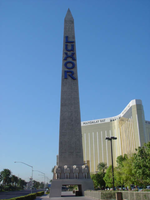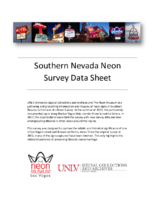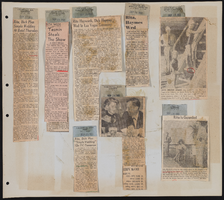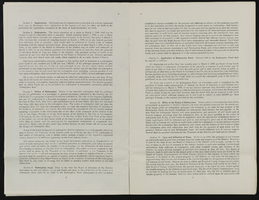Search the Special Collections and Archives Portal
Search Results
Karl Carsony Papers
Identifier
Abstract
The Karl Carsony Papers (1918-2011) are comprised of photographs, newspaper clippings, ephemera, and artifacts representing Karl (Schrom) Carsony's acrobatic career and personal life. The bulk of the materials in this collection date from approximately the early 1950s through the late 1970s. The materials also include vacation photographs of Karl (Schrom) Carsony and his wife, Margot Meyers. The materials also include promotional photographs, posters, and fliers for the Carsony Brothers, which was an acrobatic show consisting of Karl Carsony and his twin brothers, Joe and Bert Schrom.
Archival Collection
Bob McCaffery Collection on the Save the Hughes Flying Boat Campaign
Identifier
Abstract
The Bob McCaffery Collection on the Save the Hughes Flying Boat Campaign (1980-1983) documents efforts by activists to preserve the plane from destruction and its subsequent acquisition by the Aero Club of Southern California in 1980. The collection contains photographs and newspaper clippings about the Hughes H-4 Hercules flying boat nicknamed the "Spruce Goose" from the 1980s.
Archival Collection

Dr. Deborah Kuhls oral history interview: transcript
Date
Archival Collection
Description
Oral history interview with Dr. Deborah Kuhls conducted by Barbara Tabach on December 29, 2017 for the Remembering 1 October Oral History Project. In this interview, doctor Deborah A. Kuhls describes the preparation and procedures implemented at the University Medical Center of Southern Nevada (UMC) during the night of the October 1, 2017 mass shooting in Las Vegas, Nevada. She describes her experiences from that night and into the next morning, starting from when the trauma center first learned about the shooting to when patients began arriving. She goes into detail on the hospital's Military-Civilian Trauma System Partnership, which allowed for the installation of a second trauma area to treat the large volume of patients. In addition to the events at the hospital, Kuhls talks about the flurry of activities during the week of the shooting, including interviews with various media, the statewide meeting for surgeons, fellows, and residents where "stop the bleed" training was provided, and general meetings with various government officials, including Donald Trump. Deborah Kuhls also discusses the emotional impact of the shooting and its aftermath as well as her goals for the future of trauma in the medical field.
Text

Fernando Romero oral history interview: transcript
Date
Archival Collection
Description
Oral history interview with Fernando Romero conducted by Laurents Bañuelos-Benitez on October 2, 2018 for the Latinx Voices of Southern Nevada Oral History Project. Barbara Tabach also participates in the questioning. Fernando Romero was born in El Paso, Texas in a musical home. His father and brother were avid music players, and his brother left El Paso to play in orchestra in Las Vegas. Despite not being as passionate about music as the rest of his family, music was Romero's ticket to higher education. Romero attended University of Nevada South before it was renamed University of Nevada Las Vegas. Romero has gone on to be deeply involved in the Las Vegas community. He is the current president of Hispanics in Politics. Subjects discussed in this interview include: Hispanics in Politics, Nevada Association of Latin Americans, and education.
Text

Photographs of Luxor signs, Las Vegas (Nev.), 2002
Date
Archival Collection
Description
Site name: Luxor (Las Vegas, Nev.)
Site address: 3900 S Las Vegas Blvd
Sign owner: Mandalay Resort Group
Sign details: The giant black, glass, pyramid rises out of the desert as certainly one of the most unique structures. The pyramid is also accompanied by a monolithic, heavily geometric structure, finished in the same black, panels of windows. Just to the north. The front of the property is dominated by an array or Egyptian architectural landmarks such as an giant obelisk, the Sphinx, various statues of Egyptian gods and pharaohs line the multi tiered expanse of concrete and stucco. The property is pedestrian interactive, being able to pass underneath the giant obelisk, and through and beneath the giant Sphinx. The feel produced by area is appropriate for the desert environment.
Sign condition: Structure 5 Surface 5 Lighting 5
Sign form: Pylon; Fascia; Porte-cochère
Sign-specific description: On the expanse of concrete in front of Las Vegas Blvd, just north of the obelisk, a double-sided pylon sign joins the ancient composition. The pylon actually is more akin to the pylons seen at properties such as the Monte Carlo or the Mirage. It is located in the northern portion of the property on the west side of the strip-facing northwest along Las Vegas Blvd Two square posts support a two-sided square cabinet which houses a back lit advertisement and a set of crafted letters spelling the name of the establishment. Occupying the upper portion of the space between the legs another internally lit, two sided, cabinet, atop a small pair of internally lit sculpted cabinets. From a distance the cabinets look like thumbs holding up the cabinet. The shapes are graphically treated on the surfaces to look like colorful recreations of a hieroglyphic bird, the wings being the elongated portion of the cabinet. The only art attached to the cabinet is the portion designated for the head of the creature. Three sets of sculpted cornices, create borders for the different planes. The bases of the legs are treated with the ledging, the section separating the top cabinet, from the rest of the sign, and finally another set around the top crowning edge of the sign. Both sides of the top edge have a sculpted element in the very center. A flat circle, presumably a representation of the sun, flanked by two snakes are set on a pair of large wings spreading to either side. This element is ambiently lit from underneath. The text, which spells "Luxor," is composed of polished gold channel letters, with closed faces with graphic treatments in blue upon the faces. The faces are painted to appear if the letters are faceted into three dimensions. They are lit from behind with whit neon creating a halo effect around the letters. The surface of the actual structure is finished to appear as if it is constructed of limestone, utilizing false joints and seams. The south end of the property close to the street is the four-sided obelisk. The text on the obelisk is the same word treated in the same fashion, structurally and aesthetically, as the pylon sign. The only difference is that it reads vertically from top to bottom. Statuary adorn the base of the obelisk in a repeating pattern as well as it being covered in hieroglyphic patterns. A tunnel allows for the pedestrian to pass underneath the obelisk. The porte cochere is located underneath the body of the Sphinx, another use of the architecture to incorporate the pedestrian element. If you head east through the sphinx, a tunnel opens up into a small courtyard where a shuttle bus may be caught. The ceiling of the porte cochere is adorned with a circular chandelier, composed of metal representations of leafy branches radiating around a rounded center. The ends of the arms hold length-wise half cylinder lamps. The ceiling above is painted blue. The most spectacular element of the Luxor is its super powerful light in the place of the capstone at the very peak. The beam is one of the most powerful lights in the world, and can be seen from high above into the earth's atmosphere as well. The edges of the pyramid are also raceways, which can be seen in action in the dark. An animation of bulbs makes it appear as if a single bulb of light streams up the base to the very peak. The animation runs at an interval of every couple of seconds. On the very south edge of the property, actually on the southeast corner, is a sculpted, small pylon which houses a color led screen.
Sign - type of display: Neon
Sign - media: Steel; Masonry
Sign - non-neon treatments: Plaster
Sign animation: Chasing
Sign environment: Standing next to the Mandalay Bay on the west side of the southern end of Las Vegas Blvd, the Luxor's front exterior is a sprawling mass of smooth vertical planes turning into eloquent statue and stucco walls. They are interlaced with drives and signage complete with a platform at the base of the Sphinx, which is just east of where the valet and porte cochere are grounded in the base of the beasts belly. From the edge of a Platform a tram station is located and also a view of the signage can be seen as well. The Luxor's environment is a very pedestrian one as well. Being in an isolated part of the strip, the noise clutter brought about by the surging traffic is considerably better than the heart of the strip.
Sign designer: Veldon Simpson
Sign - thematic influences: The theme of the Luxor is obviously that of ancient Egypt. The Ancient Egyptian imagery is placed among the same images but represented in the shiny black glass, giving a touch of future meets the past. The image seen are some of the most commonly seen images when talking about the Ancient Egyptian culture. The Sphinx stands guard at the base of the giant black pyramid, one sign is attached to an obelisk. Various statuary adorn the entire plaza. The environment created with the motif obviously fits into the desert like dust, but still retains the surreal nature associated with the themed hotel. The aesthetics appear to be fantastic, but are a bit odd due to the arrangements and limitations on space. It does however fir into an interesting sub category of resort that is themed around a culture. Yes it is themed around a city, but the culture shines through with more dominance. Another example of this is the Imperial Palace. It is not necessarily themed after a particular city, but the architecture and imagery suggests the Asian culture.
Surveyor: Joshua Cannaday
Survey - date completed: 2002
Sign keywords: Chasing; Pylon; Fascia; Porte-cochère; Neon; Steel; Masonry; Plaster
Mixed Content

Jean Munson oral history interview: transcript
Date
Archival Collection
Description
Oral history interview with Jean Munson conducted by Vanessa Concepcion, Cecilia Winchell, and Stefani Evans on November 30, 2021 for Reflections: The Las Vegas Asian American and Pacific Islander Oral History Project. Jean discusses her childhood growing up in Guam, the nursing career path of her parents, and her decision to pursue an "unconventional path" as a comic book artist. She talks about her education at the University of Nevada, Las Vegas, her passion for the Asian American Pacific Islander (AAPI) community within Las Vegas, and her roles in community activism and leadership. Jean also shares her current pursuits as a podcaster of Bruha Baddies, co-owner and printer of Plot Twist Publishing, and co-founder of the Comic and Zines Festival.
Text

High Hat Regency Neon Survey document, September 6, 2017
Date
Archival Collection
Description
Site address: 1300 S Las Vegas Blvd
Sign owner: Tarighi Bahman and Farideh
Sign details: The building was constructed in 1958 (Assessor). A vintage postcard from the 1950's-- or more likely the 1960's (based upon the automobiles pictured)-- shows that the business was previously named the Chevron Motel (Las Vegas motels then and now).
Sign condition: Condition is 3-4, fair to good. The pole, cabinets and reader board are in good condition. Moderate rust is evident around the edges of the top cabinet. The paint is generally in good condition, although there white patches (from repairs?) on the chevron. The neon tubing is entirely intact. Most of the incandescent light bulbs are present, except for the underside of the lower cabinet, where they are completely absent.
Sign form: Pole Sign
Sign-specific description: A single round white metal pole supports the sign, which is cantilevered toward the street. The cabinets form a rectangular "C" which is open on the motel side. The interior of the "C" surrounds a chevron which points toward the motel. On top of the motel side of the upper cabinet is a metal top hat and cane. The sign is attached to the pole at the side of the lower cabinet, the point of the chevron and the bottom of the upper cabinet. The background color of the sign is sky blue. The bottom of the face of the lower cabinet has the word "VACANCY" painted in white sans serif letters. The letters are traced in white skeleton neon. To the left, the word "NO" is spelled out in clear skeleton neon sans serif letters. Above the neon letters is a white metal reader board which has a row of clear incandescent light bulbs running along the top, bottom and motel side edges. A single row of clear incandescent light bulbs runs the entire length of the street side of the sign. On the street side of the chevron is a blue metal cabinet with the word "MOTEL" spelled in white channel letters. The channels are outlined by white neon tubes, while the interior of the channels are filled with clear or white incandescent light bulbs. On the motel side of the "MOTEL" cabinet is a blue chevron which is covered with clear or white incandescent light bulbs. The top cabinet features the words "High Hat" spelled out in white cursive letters. Below is the word "REGENCY" painted in white sans serif letters. All wording is traced by white skeleton neon. On top of the motel side of the upper cabinet is a white top hat with a blue hat band. Running through the hat is a white cane. The hat and cane are traced by white skeleton neon. The hat is covered with white or clear incandescent light bulbs.
Sign - type of display: Neon, incandescent, reader board
Sign - media: Steel, plastic
Sign - non-neon treatments: reader board
Sign animation: Light bulbs flicker
Sign environment: Las Vegas Boulevard South, north of the Las Vegas Strip near other motels and wedding chapels.
Sign - date of installation: c.1950s
Sign - thematic influences: Elegance, sophistication, high society, boomerang/chevron, 1950's, 1960's, mid-century
Survey - research locations: Assessor's website
Survey - research notes: Connolly, D. (2012 July 21). Chevron Motel. Retrieved from https://www.flickr.com/photos/dennisconnolly5059yahoocom/7635650456 Hagopian, M. (2011 January 28). No vacancy in vintage Vegas. Retrieved https://hyperallergic.com/15738/no-vacancy- vintage-vegas/ Las Vegas motels then and now. (n.d.). Chevron Motel. Retrieved from http://stefanidrivesvegas.com/8.html RoadsideArchitecture. (n.d.). High Hat Regency Motel. Retrieved from http://www.roadarch.com/signs/nvvegas.html Seltzer, D. J. (2014 June 1). High Hat Regency Motel sign in Las Vegas [Video recording]. Retrieved from https://www.youtube.com/watch?v=-bQdw48LVrA
Survey - other remarks: A vintage postcard circa 1950's-1960's shows the Chevron Motel sign as a simple pole mounted with a reader board and two light boxes which form a "C" shape open toward the motel (Las Vegas motels then and now, n.d.). A later postcard features the same sign with a chevron in the center and a semi-circular arch which encloses a light ball above the upper cabinet (Connolly, 2012). The current sign retains the chevron, the metal frames of the light boxes and reader board (Las Vegas motels then and now, n.d.). A hat and cane have replaced the arch and light ball at the top of the sign (Las Vegas motels then and now, n.d.). The light boxes have been replaced with metal cabinets with incandescent and neon displays (Las Vegas motels then and now, n.d.). The sign is pictured in a vintage postcard circa 1950's-1960's (Las Vegas motels then and now, n.d.). At that time it advertised the Chevron Motel.
Surveyor: Mitchell Cohen
Survey - date completed: 2017-09-06
Sign keywords: Neon; Incandescent; Steel; Plastic; Reader board; Pole sign; Flickering
Text



